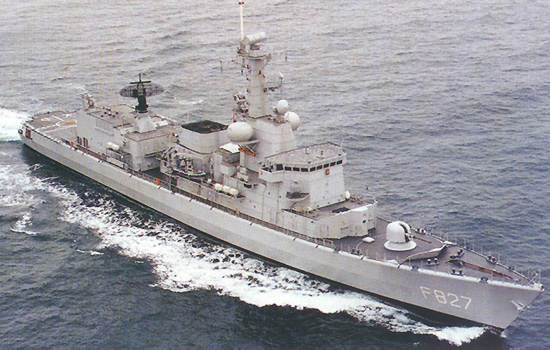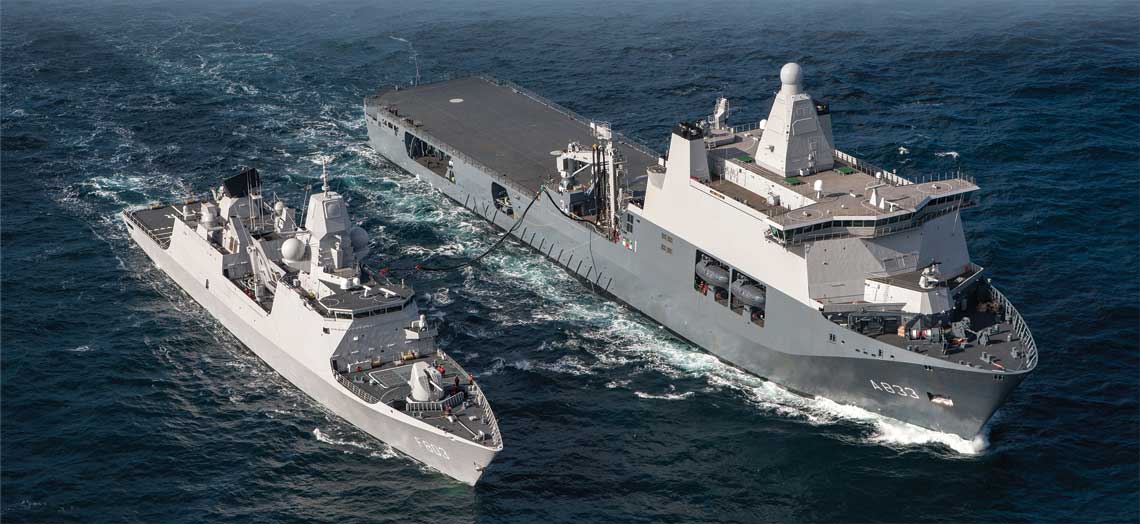
Karel Dorman is the only one

A Tromp-class LCF frigate being refueled at the Porter. Noteworthy are the large flight deck, PAC masts, cranes, hybrid ice side cavities, landing craft and rescue craft. Most of the electronic systems are centered on the integrated mast. Koninkleike Marine Photos
Readers interested in modern ships have probably noticed that supply and transport units, or more broadly, logistics units, are an important link in globally operating fleets. Increasingly, these are large and versatile ships, combining in their design the features characteristic of several classes of older generations. This is the result of much-needed savings in armaments, as well as a shift in the center of gravity of maritime operations from oceanic to coastal waters from remote areas of the globe.
In October 2005, the Ministry of Defense of The Hague published the Marinestudie 2005 (white paper), which was a package of proposals for the composition of the naval forces and a change in priorities, containing ideas about the units most suitable for long-term tasks. It was decided, in particular, to abandon the still very young M-type frigates built for the needs of the Cold War (two were saved and modernized). Their cost allowed a quick sale abroad (Chile, Portugal, Belgium). The vacated place in the ranks was to be taken by four ocean-going patrol ships of the Holland type. In addition, a decision was made to build the Joint Logistics Ship (JSS), a "Joint Logistics Ship".
Controversial nature
The assumptions for the JSS were formulated by the Defense Supply Authority (Defensie Materieel Organisatie - DMO). As a result of the analysis, the focus was on new methods of projecting energy from the sea and the growing need to work in "brown" waters. It turned out that more and more units are operating close to the coast, supporting operations on it, up to the development of internal operations. This means not only the need to transport troops and equipment, but also the possibility of providing logistical support from the sea at the initial stage of the operation of the ground forces. At the same time, attention was drawn to the need to replace the old fleet tanker ZrMs Zuiderkruis (A 832, written in February 2012). The desire to limit costs led to the decision to pool resources to solve these - somewhat contradictory - tasks on a single platform. Thus, the functions of the JSS include three main aspects: strategic transportation, replenishment of tankers and solid stocks of ships at sea, and support for combat operations on the coast. This required the creation of a unit capable of storing, transporting, self-loading and unloading supplies, fuel, ammunition and equipment (at sea and in ports with various infrastructure), providing air operations using heavy transport helicopters, also equipped with medical, technical and logistics facilities. , as well as additional accommodation for personnel (depending on the nature of the mission) or evacuated military or civilians. The latter was the result of additional requirements for participation in humanitarian missions and the evacuation of people. As it turned out, the concept of “humanitarian mission”, which is somewhat abstract for us, became the first action of the new ship and before its start of service!
The work to define the DMO was completed in 2004, already then with the help of the Damen Schelde Naval Shipbuilding (DSNS) office in Vlissingen, the future contractor of the unit. They required a flexible approach to the issue and frequent access to financial and technical compromises, as well as the coordination of the three principles mentioned above in terms of mass, volume and location of individual sections of the ship structure. In addition, stringent safety and environmental requirements had to be met. All this influenced the final appearance of the unit, which was the result of adjusting the need to take the appropriate fuel supply, the length of the cargo lines, the landing area, the dimensions of the hangar and ro-ro deck, as well as the separation of ammunition depots from containers with flammable liquid. This approach to the design of the interior of the ship, in turn, influenced other important decisions - primarily on transport routes. They should be as short as possible and well connected to the location of onboard cargo handling equipment, as well as access to barges and helicopters. A separate problem that needs to be addressed was the changing requirements for impact resistance, floodability and acoustic signature of the engine room and ship equipment.
In June 2006, pending parliamentary approval of the program, further conceptual work was initiated. JSS was then predicted to enter the formation in 2012, assuming that
that the construction of the Holland and JSS patrols will be carried out in parallel. However, the limited possibilities of their financing led to the indication of a priority - patrol ships. This resulted in a nearly two-year break in the program, which was used to further optimize costs and pre-production.
At the end of the first quarter of 2008, DMO formulated the performance requirements for JSS and soon contacted DSNS with a request for quotations. Compromises had to be made to keep the unit price at the level of 2005 million euros adopted by Parliament in 265, despite its size and complexity. The restrictions adopted included: reducing the maximum speed from 20 to 18 knots, removing one of the 40-tonne cranes, lowering the superstructure to the level planned for accommodation cabins, reducing the height of the hangar, or eliminating the incinerator.
Despite these adjustments, the overall layout of the unit has not undergone major changes since the start of design work. The need to operate in various regions of the globe and the wide transport possibilities forced the use of a large body. It was difficult to combine this with the ability to operate in shallow water in the immediate vicinity of the unarmed coast, therefore, this feature is not required at all. It is effectively replaced by a transport helicopter or landing craft. Their operation on the high seas is facilitated by large, stable hull "logistics". Its silhouette is most influenced by the size and location of the cockpit, which is due to the need to simultaneously operate two Boeing CH-47F Chinook twin-rotor heavy helicopters. The use of these machines also determined the size and location of the hangar - since they do not have folding rotor blades, it was necessary to place it on the landing site and use large gates. Its height was originally intended to allow replacement of the main gears, but as mentioned, it was ultimately abandoned. Instead of the Chinooks, the hangar will house six smaller NH90s with folded rotor blades. Helicopters should become an important means of quickly transporting personnel and parts of cargo.
The second significant room of the ship in terms of strategic transport is the cargo deck for trailers (ro-ro). It has an area of 1730 m2 and has a 617 m long cargo line for cargo rental, but not only. This is a flexible area of the hull, 6 m high, where containers and pallets can also be stored. The ro-ro deck is connected to the landing area by a 40-ton lift, the platform of which is designed to carry Chinook, but with a disassembled rotor. Thanks to this, the flight deck can also be filled with vehicles or cargo in standard packages, which together with the hangar area gives an additional 1300 m of loading line. Access to the ro-ro deck from the outside is provided by a hydraulically raised ramp with a lifting capacity of 100 tons, located in the starboard aft corner of the hull.
An important stage in the transport chain is the transshipment of the heaviest cargo at sea onto barges or pontoon parks. The best solution would be to use the pier at the stern of the ship. However, this will complicate the design of the installation and increase the unit cost of construction. Therefore, a short stern ramp was used, when approaching which the barge can slightly sink into the recess in the hull and, leaving its own bow ramp, take the cargo (for example, a vehicle) directly from the ro-ro deck. This system is designed to work with sea waves up to 3 points. In addition, the vessel has two high-speed landing barges suspended on turntables.
On December 18, 2009, DMO signed a contract with DSNS that created one JSS. The construction of ZrMs Karel Doorman (A 833) was mainly carried out at Damen Shipyards in Galati.
in Romanian Galac on the Danube. The laying of the keel took place on June 7, 2011. The unfinished ship was launched on October 17, 2012 and towed to Vlissingen, where it arrived in August 2013. There it was equipped and prepared for testing. In September 2013, the MoD announced that, for financial reasons, the JSS would be put up for sale after construction was completed. Fortunately, this "threat" was not realized. The unit's christening took place on March 8, 2014, by the then Secretary of Defense Jeanine Hennis-Plasschaert. However, Doorman was unable to enter service and complete further sea trials as scheduled, and this was not due to technical problems.